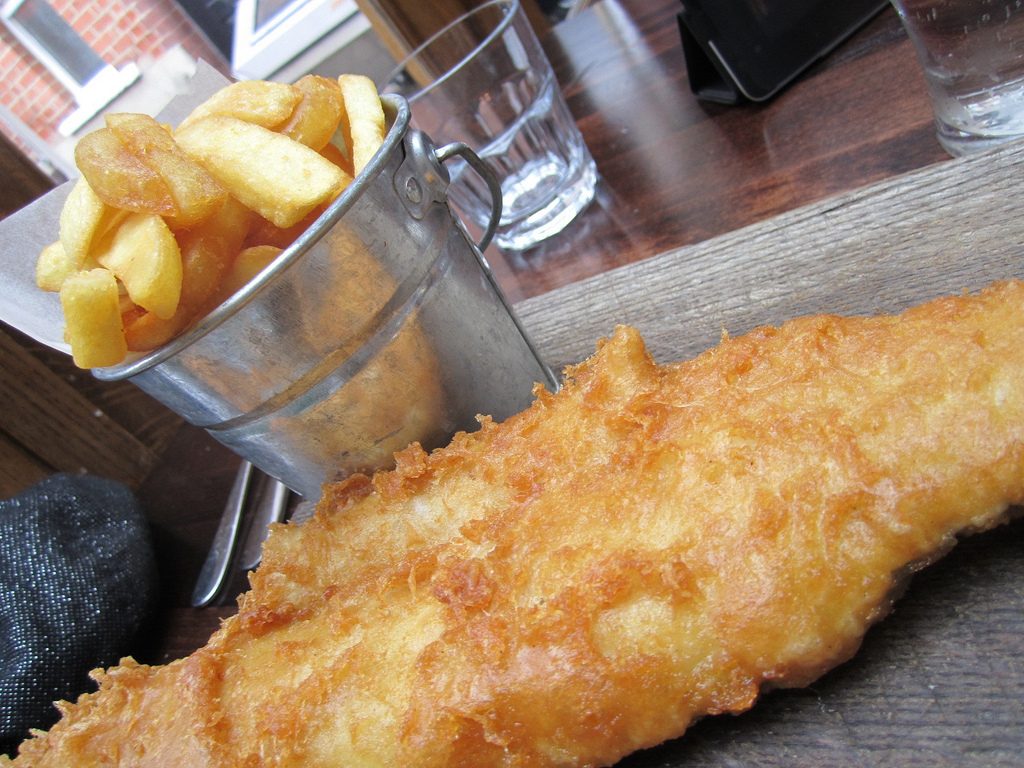Story of an English Meal – Fish ‘N Chips Posted by Gary Locke on Feb 22, 2018 in Culture
Warning: This blog may induce extreme hunger!
Imagine a meal which is a national institution in one country yet is eaten all over the world and owes its origin to several diverse cultures. How you eat it, serve it, and even select one of the principle ingredients is determined by where you live. Yet, essentially, it is the same dish everywhere. And, my word, is it good! Welcome to the story of fish ‘n chips.
History of a Meal
We trace the origins of this most English of meals to Sephardic Jews who emigrated to Great Britain in the latter part of the 18th century. These refugees from across Europe typically would procure locally caught fish on Friday, coat it in dried breadcrumbs, then fry it and serve it cold for Shabbat. This was done at fish warehouses, which sold fried fish with bread and baked potatoes in locations throughout London, such as the Soho district. Charles Dickens refers to them in a chapter in Oliver Twist, written between 1837 and 1839, and Thomas Jefferson in his diary wrote of eating fried fish in the Jewish fashion when he visited London late in 1786.
You can’t have fish and chips without the chips, however. The potato was introduced to Europe by Spanish explorers who first encountered them in Central and South America. Frying in oil was a typical cooking method of the Spanish at that time. Initially quite small, potatoes would have been cut into the chips that we know today, then fried. When the potato was cultivated across Europe, and later North America, larger varieties were developed, and the French pommes frites, cut lengthwise before frying, was born. Incidentally, the first American known to have made french fries? Thomas Jefferson.
The Chippie
Spanish and Portuguese Jewish emigrants to Britain almost certainly were the first to combine the identical methods of frying fish and potatoes and serving the two together, but there is a dispute as to where the first fish and chips shop was located. You would think that the first shop would have been found near the seaside. In fact, whichever location you accept as the first, it most certainly was not near the ocean.
We know with reasonable certainty that Joseph Malin, an enterprising 13-year-old boy from East London, sold fried chips from a basket around his neck in the streets of his neighborhood, beginning around 1860. Within a brief time, he added fried fish to his basket, wrapping the two together in old newspapers so they could be enjoyed together. This tradition of serving the meal in paper continues in many places today. Soon, Malin opened his own storefront “…within the sound of Bow Bells”, where the shop remained in his family until the early 1970s.
However, John Lees from Lancashire, a district well north of London, claims to have opened the first fish and chip shop (or, chippie, as the Brits call them). He began by frying the two together in a wooden hut in a market in the small town of Mossley and later opened a shop directly across the street in 1863. It was also his home. Many subsequent chippies were founded out of the front of a family home. The great filmmaker, Alfred Hitchcock’s home was a chippie. Mossley has since been absorbed by the larger city of Manchester and, believe me, residents will vociferously claim that Lees’ chippy was the original shop. At its peak, in the 1920s, there were over 35,000 chippies throughout England.
None of this would have been possible, however, without the Industrial Revolution. Steam-powered trawlers from the North Atlantic delivered freshly caught fish to ports, and newly devised methods of preserving fish in ice preserved the fish long enough to make the journey on steam-powered trains anywhere in England. It also meant that shops could now offer cheaper, lesser-known fish such as plaice, haddock, skate, and whiting. The fish you select is probably going to depend on where you live. The favorite among most Britons today is cod.
Cooking and Serving
Floury potatoes, as compared with waxy, are preferred for today’s chips because they are less prone to being greasy, and they are likely to be cut in the now common french fry shape. They are thick cut, so the potato doesn’t absorb the grease, and are flash fried twice for thorough cooking and crispness. The fish is dredged through a mixture of sifted flour and beer, then dusted with more flour, then fried in oil which has been heated to 375 degrees F.
There are numerous traditional accompaniments, again depending on where you live. The English often insist on mushy peas, which have been mashed with added lemon and salt. Many also favor malt vinegar, pickled onions, or curry sauce. In Scotland, you might be served a brown sauce called chippie sauce. In the United States, you will typically be served your fish and chips with a slice of lemon and tartar sauce, which combines mayonnaise, lemon juice, and mustard. Another favorite with many Americans is ketchup. Some countries favor a side of aioli, a smooth garlicky mayonnaise.
Are you hungry yet?

Build vocabulary, practice pronunciation, and more with Transparent Language Online. Available anytime, anywhere, on any device.




